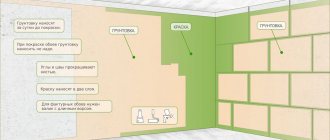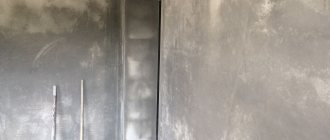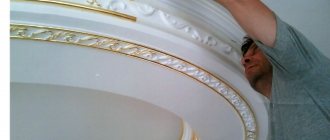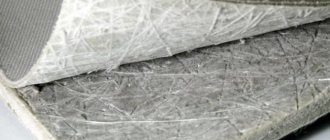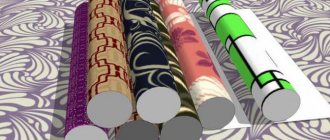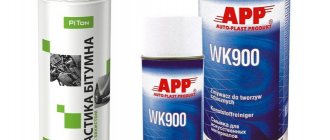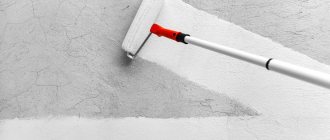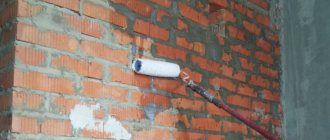Why is wall priming necessary?
Before painting, the surface is leveled using various materials. Drywall, plaster and others are often used, then putty is applied. If you do this correctly before painting, you can prevent changes, cracking and other defects. Then primer is applied to the walls. It is necessary to carry out preparatory work for the following reasons:
- To improve adhesive properties, due to which the finishing material adheres to the base coat. The primer allows the paint to better adhere to the surface, preventing it from peeling and cracking. Subsequently, it is not difficult to prepare for repainting;
- Helps reduce the degree of moisture absorption by the surface. This is especially important for walls after applying plaster, putty and other special materials;
- To strengthen the foundation. Weakened, porous and loose wall structures become strong and solid due to the penetration of a special substance inside. This is especially typical for compositions that penetrate 8-10 cm into the material;
- After applying the plaster, the development of fungus and mold is prevented. A wall primer containing fungicidal substances, used for painting, allows you to cope with existing problems on wall structures;
- The substance prevents the appearance of red spots on wallpaper and other finishing materials during use;
- Reduces paint consumption. Primed walls do not absorb large amounts of substance. During the work, a uniform decorative layer is created.
In the process, it becomes possible to get by with one coat of paint where you have to paint 2-3 times without a primer. This contributes to significant savings in money and consumables.
The primer allows the paint to better adhere to the surface, preventing it from peeling and cracking.
How to choose the right primer
To achieve the best results, it is important to choose the right primer with the right composition, taking into account factors such as the type of coating and the conditions in which the work will be done.
If you need to paint walls with a completely non-absorbent, dense surface (previously painted or concrete walls), or you have to hang heavy wallpaper, then non-contact primers and adhesives are suitable here. They increase adhesion (cohesion) due to quartz and sand particles in their composition. This will create the highest level of grip possible.
If you work with metal surfaces, anti-corrosion compounds are suitable for you. They will prevent rust from appearing and increase durability.
If the object of your attention is the bathroom or kitchen, antiseptic primers designed for wet areas are suitable. Its special composition reduces the likelihood of fungus. Also, such a primer provides such high adhesion that it does not allow microorganisms to penetrate into the joint.
If the surface that needs to be primed is loose and not very durable, a deep penetration primer will help. This mixture will strengthen the wall and reduce paint consumption.
Pre-treatment before painting
Before starting the main work, it is recommended to plaster the walls, having previously cleaned them of dirt and dust. To prepare the surface after traces of previous repairs, remove paint and tear off wallpaper. After this, the cracks, cracks, and irregularities are sealed using various soils.
There are special universal compositions that not only improve the properties of the material indoors, but also contribute to better adhesion of substances outside the building. After preparing the surfaces, paint is used.
Before starting the main work, it is recommended to plaster the walls, having previously cleaned them of dirt and dust.
Is primer needed when painting a putty part?
Some craftsmen, in order to save money, try to paint completely puttied parts without primer. But the savings are negligible, meanwhile the quality of the painting suffers. The fact is that it is unlikely that it will be possible to wash off the putty so that after painting no risk appears. Usually they also add a developing layer to bring the polishing to perfection.
The pore size of filling primers is much smaller than that of automotive putties. Accordingly, the primer washes out much better. In addition, it fills in all surface defects of the putty itself. Therefore, it is necessary to prime the putty.
Primer preparation
Having decided on the question of whether it is necessary to prime the walls before painting, we will consider the available options for the substance. Some are already ready. It is enough to mix them and you can start repair work. Others need to be prepared. To do this, the dry mixture is filled with a sufficient amount of water. It is necessary to ensure that the solution has the desired consistency. If it is too liquid it will run off the walls; if it is too thick it will be difficult to apply on the surface.
Each is suitable for plastering one or another material. Before use, the selected primer is thoroughly mixed until a uniform layer is formed. To improve the properties of the plaster, let it sit for 15-20 minutes. After this, the mass is mixed again. Then you can start priming the walls.
After applying each layer, the walls must dry. This usually happens within 24 hours. The substance dries faster in hot and dry conditions. When the surfaces are smooth, you can start painting.
Before use, the selected primer is thoroughly mixed until a uniform layer is formed.
Types of primers
There are many options on the market for primers that can be used before painting. Having decided on the question of whether or not it is necessary to prime the putty before painting, you need to choose the right option for the job. Let's talk about each type in detail:
- Wooden, concrete, plastered material is treated with a polyvinyl acetate type of priming;
- Before painting, the brick wall is treated with silicate;
- Acrylic is a universal material. It can be used to process internal and external coatings;
- Treat metal and wood with alkyd;
- Aluminum is used for painting wood;
- For deep treatment of structures outside and inside, epoxy is used.
Select a primer depending on the type of wall being treated. Otherwise you will damage the structure. If it is difficult to decide on an option on your own, contact the seller for advice. He will give advice on what is suitable in a given situation.
Select a primer depending on the type of wall being treated.
Preparing the walls
Some owners believe that there is no need to prime the walls after puttying. If this is not done, the leveling layer will crumble during operation and absorb a lot of paint, which will significantly increase its consumption.
There are also special wallpapers that are designed for painting (painting non-woven fabric). They do not need to be subjected to special preparation, but the walls are primed before pasting the wallpaper itself. The plasterboard surface is treated in two layers. The first layer is applied immediately after installation, and the second layer after puttying.
If new paint is applied to an old layer, then such a surface needs to be primed only if there is a difference in color between the old and new layers.
Before priming, the room and walls need to be prepared.
- We remove everything that may interfere with the work process. If it is not possible to remove the furniture, then we move it to the middle of the room.
- We keep the room temperature from 5 to 25 degrees.
- The walls must first be thoroughly cleaned of all dirt and grease stains. To do this, you can wash them with hot water and a small amount of ordinary detergent.
- If there is damage on the walls, we cover them with putty, trying to achieve the most even surface possible. If necessary, we carry out mold removal work.
- Rub the putty with a block or medium-grit sandpaper. Be sure to wait for it to dry completely.
- A couple of hours before applying the primer, clean the working surface.
- Apply primer.
- The walls must be completely dry. If the humidity is high, then ventilate the room or dry the walls with a heat gun.
Let's figure it out: what kind of wall
Walls made of wood are light and resistant to deformation. Such walls can last more than 100 years. But wooden surfaces have a drawback - their susceptibility to external influences (insects, high humidity, sunlight).
The primer makes the wood more protected from unwanted influences, since after priming the surface of the wood becomes more durable and less permeable to insects.
Brick walls, unlike wooden ones, are not susceptible to insects, are durable and fireproof. It may take several days to warm a brick house to comfortable conditions due to its high heat capacity. Brick walls, due to their strength and resistance to external factors, can theoretically do without priming, but this is undesirable. A primer is a primer, that is, a preparatory and leveling agent, but brick walls are not smooth and uniform. Therefore, it will be easier to achieve perfect coverage. This will also increase the durability of the finish.
Walls made of lightweight concrete (foam concrete, expanded clay concrete), like the previous ones, are fireproof (can be adjacent to stoves, fireplaces, etc.) and are not susceptible to insects. Concrete is a fairly porous material, and dust, moisture, and dirt can become clogged in the pores. The primer mixture fills these pores with a durable film, leveling the surface. And adhesion, i.e. adhesion will be significantly higher than to concrete.
Frame walls are the lightest of all those considered, so they warm up quickly and are resistant to deformation. They are susceptible to rotting and insect attack, and therefore require special treatment and protection. The primer will just create a protective layer and make the walls more resistant to the negative effects of the environment.
In general, the primer will not harm any type of coating; moreover, it will simplify the finishing and increase its durability.
Tools you will need for the job
If you are going to apply primer to the walls before painting, you need to acquire the following tools:
- Apply the substance with a roller;
- To apply in difficult places you need to use a brush;
- Spray bottle;
- Container for primer.
The tool is selected based on the situation. If you need to paint drywall, use a roller. The brick is processed with a brush.
If you are going to apply primer to the walls before painting, you need to acquire tools.
Which primer is better for puttying and painting?
The choice of type of impregnation for walls depends on the material being applied, the type and structure of the surface.
- Prime the walls before painting with water-based or acrylic paint. Before applying water-based or acrylic compositions to concrete, plastered, puttied or previously painted surfaces with similar compositions, it is recommended to use liquid acrylic primers for painting.
- The same impregnating liquids can be used for putty, but the bases must be dense and have good adhesion to them. In the presence of paint and varnish coatings, it is advisable to use concrete contact.
- Pigmented compounds are used to even out the overall color background - to lighten a dark base. Suitable for paints and decorative coatings - wallpaper, plasters, putties.
- The antiseptic composition must be used, regardless of the coating used, in the presence of temperature changes and high humidity.
How to apply paint primer
When asked whether or not materials need to be primed before painting, many craftsmen answer positively. As a result of the treatment, the coating is strengthened and protected from the negative effects of the environment. Apply the solution as follows:
- Cover the entire surface evenly;
- Putty is applied on top;
- The wall structure is primed again.
In order for the substance to lie flat, you need to roll the roller over the material, and then carefully move it along the wall.
As a result of the treatment, the coating is strengthened and protected from the negative effects of the environment.
Choosing putty for walls after plastering
While the primer dries, you need to choose what to putty on the walls after plastering, since they need to be leveled before further finishing. For this purpose, it is better to purchase a starting mixture: it is designed specifically for treating walls after plastering, and is suitable for eliminating significant differences in height.
Also, when the primer dries after plastering the walls, you can treat their surface with universal or finishing putty. The latter, in comparison with the starting mixture, have comparatively worse consumer characteristics, and are usually used in cases where the plaster layer does not have significant flaws.
Based on the material, putty bases are divided into three categories:
- cement - resistant to moisture, but have a high degree of shrinkage;
- gypsum - cheap, does not shrink, is pliable when applied, but is sensitive to humidity levels;
- polymer ones are expensive, do not shrink, and are resistant to moisture.
Most often, gypsum-based putties are used; however, their scope of use is limited; they are not recommended for use in very wet areas where there is contact with water in the bathroom or swimming pool. Otherwise, why putty the walls after plastering if, due to high humidity, the gypsum-based coating will quickly become unusable.
It is strictly forbidden to use gypsum plasters outdoors since moisture and frost destroy the Rodband mixture and other similar ones.
According to the sales form, putties are presented in two categories:
- ready-made - an already diluted solution that can be used immediately after opening the container;
- dry - mixtures intended for self-preparation, but having a much lower cost than ready-made mixtures.
Thus, the cheapest option is dry gypsum powder, but it also has the lowest quality. Gypsum mixtures are excellent for sealing cracks in walls. The most expensive are ready-made polymer-based putties; these materials are best used for making the finishing layer.
Technology for processing plastered walls
Often, before starting putty work, the question arises as to whether the beacons need to be pulled out after plastering, or whether they can be left in the walls. It is recommended to do this without fail. The beacons are made from metal, and if left, they will corrode over time. This, in turn, will reduce the strength of the plaster layer, and ultimately lead to its crumbling. Cracks and other damage will appear on the surface of the walls.
After the decision has been made whether it is necessary to choose beacons after plastering, you can begin to putty the surface. The bottom, coarsest layer of material is applied. Using mixtures for starting putty, holes and grooves are filled in and large differences in height are eliminated. The thickness of one starting layer can sometimes reach 15-20 mm.
You can put a painting mesh under the putty layer, stretching it over the entire surface of the wall being treated. This will make it possible to achieve a more even laying of the material and improve the strength of the starting layer of putty.
When the starting coating has dried, the finishing process begins, which is carried out using finishing mixtures. Unlike the starting one, it is applied in a very thin layer so that it completely repeats the resulting wall relief. In some cases, the question arises whether it is necessary to putty the walls after plastering with Rotband in order for the surface to be perfectly flat. If you follow the technology, there is no need to apply additional finishing layers, the walls will already be level.
Preparing walls for painting or wallpapering
After completing the putty work, you should wait until the walls are completely dry, and only then prepare them for painting or wallpapering. The technology for performing both types of finishing is the same; the difference lies only in the nuances when choosing finishing materials. You can spend as much time choosing the appropriate finishing method as it takes for the walls to dry after plastering - about a month.
Primer of walls for water-based emulsion
Experts definitely recommend priming surfaces before painting them with water-based emulsion. This type of paint is harmless, dries quickly, and is available in a large number of colors. The water-based emulsion is prepared by mixing white paint with coloring pigments.
When planning to apply a water-based material, you need to prime the drywall or plaster, putty it, and level it using an abrasive mesh. After this, the surface should be puttied and also sanded using a fine-grained mesh. After the substance has completely dried, the wall is primed. After the layer has dried, the surface is painted with a suitable water-based emulsion. Experts guarantee a good option, even application, and no cracks when using fiberglass.
Experts definitely recommend priming surfaces before painting them with water-based emulsion.
Work order
Each master has his own secrets on how to putty drywall under wallpaper. However, the work is carried out according to the technology in several stages:
- All joints and defects are carefully leveled.
- External and internal corners are formed.
- The puttyed areas are sanded.
- The entire surface is dusted and primed.
- Putty is applied.
- Sanding and priming are carried out for subsequent finishing.
You can control the quality of the base using the directional light of a lamp or flashlight. If defects are noticeable, you need to apply subsequent layers until the desired result is achieved.
Sealing seams, holes and defects
All recesses on the wall surface must be tightly filled with putty. Professional craftsmen recommend using the Knauf-Fugen mixture for this. It is flexible, easy to use, and fills joints well.
The putty is rubbed into the defects with little force until a roll of material is formed on the surface. It is recommended to treat self-tapping screws with Knauf-Fugen 2 times to avoid shrinkage.
To strengthen the seams, reinforcing paper tape or sickle tape is used. They protect the putty from cracking and destruction.
Sealing of seams is carried out in the following ways:
- Pre-wet the paper tape in water for better adhesion to the surface and to prevent the formation of bubbles. Fill the seam with putty and glue the tape, pressing it lightly with a narrow spatula. The tape must be completely immersed in the solution.
- Apply finishing putty to the seam. Glue the soaked tape with PVA glue to the joint. After drying, putty the entire surface.
- When using serpyanka, the seam is also first filled with putty. Remove excess mortar from the middle with a narrow spatula, then smooth the tape with your hand exactly in the center of the joint, pressing slightly. Cover with putty using a wide spatula.
There should be no voids left in the seams and holes, and no bubbles under the tape or sickle tape. Grinding begins after the solution has dried (10-12 hours).
Puttying drywall corners
The technology for processing external and internal corners differs. For external corners, special perforated profiles made of galvanized steel or plastic are used. They allow you to strengthen the joint of two sheets and give the corner the correct geometry.
The area is first covered with fresh putty. The profile is applied to the corner and pressed slightly. A portion of putty is applied on top and smoothed down so that the corner is completely hidden under it. You can pre-fix the profile with self-tapping screws.
Paper tape is used to reinforce internal corners. The joint must be coated well with putty. Place the tape over the solution and press firmly. Using a narrow spatula, carefully level it, then cover it with a small amount of putty.
Finishing putty on plasterboard walls for painting
The base for painting should be almost perfect. The task of finishing putty is to smooth out even the slightest defects.
Before you putty the drywall for painting, the entire surface must be covered with a starting mixture, dried and sanded. Clean the walls from dust and prime them. After drying, start working:
- Mix the finishing putty composition thoroughly. If it is prepared from a dry mixture, you need to achieve a uniform and smooth consistency, reminiscent of sour cream.
- Apply the mixture with a trowel onto a long spatula and spread it over the wall.
- Then rub in a circular motion over the surface in as thin a layer as possible.
- Sequentially putty each area, extending onto the adjacent one, so as not to leave rough marks from the spatula. Movements must be done with even pressure.
To speed up work and improve its quality in corners, it is recommended to use a special corner spatula. It copes well even with hard-to-reach places.
The air temperature in the room should not be lower than 10%. Drying time - 8 hours. After complete drying, begin sanding. This is a labor-intensive process, but the final result will depend on the quality of the work done.
How many times should a layer of primer be applied?
Having learned how to prime walls before painting, you should decide how many times it is recommended to apply the substance to the surface. Usually the coatings are plastered twice. For the first time, use a thicker consistency. Plaster is applied a second time to strengthen the surface well.
Plaster is applied a second time to strengthen the surface well.
Questions and answers
1. Should I prime the walls over old paint before painting?
It is recommended to prime if the color of the walls changes. Otherwise, the color may wash out, and then you will have to paint with an additional layer, wasting extra paint. The paint will not wash away the soil and will lie more evenly.
2. Do I need a primer when painting the same color?
If the walls are smooth and not covered with dust and a grease film (as can be the case in the kitchen), then you can do without a primer. If traces of dust, etc., are clearly visible on the walls, then primer should be applied before painting.
3. Is it necessary to apply a primer to putty walls before painting?
It is necessary, since dust forms on a putty wall, which is difficult to remove, which will greatly affect how the paint lays down and how it sticks to the wall.
4. In what case can the number of primer layers be reduced?
There is no need to neglect the number of primer layers prescribed by the manufacturer.
How long can it take to paint, drying time
The primer for walls for painting dries completely the next day. There are some options that allow you to start painting after 5-7 hours. Despite this, experts recommend waiting a day, which helps improve adhesive properties and strengthen the surface.
While waiting, remove open containers with water, solution residues and other substances from the room. Their presence helps slow down the drying process.
The primer for walls for painting dries completely the next day.
Application technology
To work you will need the following tools:
- protective respirator, glasses and seals;
- brushes, roller (or spray), a narrow brush is needed for processing corners, switches and other complex structures, the roller should be 18-20 cm wide with medium synthetic bristles;
- a container with the mixture, for example, a paint bath, the presence of a recess and a squeezing grid will allow you to apply the primer more evenly and without excess;
- degreaser;
- clean rag and wire brush.
Preparation
- We put on personal protective equipment.
- Prepare the mixture. Mix dry soil with warm water according to the instructions. Mix the prepared solution thoroughly before use.
- Pour the composition into the container. Dip the roller in it on both sides, and squeeze out the excess on the wire rack.
- We ensure good ventilation of the room in which the work will be carried out. The air temperature should be from 5 to 25 degrees, the air humidity should be at 60-80%.
- We sand the putty.
- Remove debris and settled dust with a broom or broom. If there are pockets of fungus or mold, we remove them with a metal brush and treat them with a concentrated antiseptic composition.
- We degrease the surface with technical acetone or any other degreasing substance.
We recommend: Table made from furniture board: manufacturing instructions
How to prepare a wall
Before applying the primer, the walls are cleaned of wallpaper residues, crumbling plaster, grease stains and burning. Remove dust from newly plastered surfaces.
If the walls are smooth, then simply wipe them with a damp cloth. Porous surfaces are cleaned of dust with fine sandpaper. Some craftsmen use compressors, special mops with attachments, and construction sponges. There are also a lot of life hacks. One of them: adapt a paint brush with high bristles as an attachment to a regular vacuum cleaner. The pile must be long so as not to scratch the surface.
Note! Removing dust from walls is accompanied by a high concentration of dust in the air. Protect your lungs. Use a respirator when working.
Sequencing
- Apply the first layer to the wall. You should start from the most convenient place in the direction from top to bottom with progressive movements. To prevent smudges from forming, the roller should be pressed lightly, but the solution should not be allowed to drain. For hard-to-reach areas, it is more convenient to purchase a special device for a roller (telescopic rod).
- Apply the solution to corners and other difficult areas with a narrow brush. Here you need to show special care and accuracy.
- Let the soil dry. This may take from 3 to 6 hours. You can tell whether the soil has dried out or not by looking at the wet spots that should disappear. The process must take place under natural conditions; a heat gun or battery cannot be used.
- If necessary, apply a second layer without waiting for the first layer to dry. The sequence is similar.
- Then we apply paint.
To process monolithic concrete, use soil with quartz sand, which is designed to enhance the adhesion of the concrete surface.
Is it possible to paint without a primer when it is necessary to apply a primer?
A primer before painting may not be used in cases of gluing wallpaper and then painting it, as well as after finishing with latex putty, which does not crumble during use.
The need for primer is established in cases where it is necessary to paste wallpaper. This allows you to securely adhere them to the walls. Plasterboard sheets must be primed with the substance. Plaster is used if you need to repaint old paint in a new tone, which helps neutralize the show-through of the previous finish.
Plasterboard sheets must be primed with the substance.
By priming any surface before painting, you make further finishing work easier. This contributes to better distribution of the paint layer and a reduction in consumables, which can save significant financial resources.
Primer base
Most often, walls are leveled with putty. Some people think that it doesn’t need to be primed, because the putty surface is already a good preparatory layer for paint. But it has disadvantages: it can crumble, and it also absorbs too much coloring composition. The primer will strengthen the base and save paint.
Paintable wallpaper does not require priming, as it is designed for application of a coloring agent.
Before wallpapering, the walls must be primed. The soil will ensure a reliable connection of this layer with the walls.
Drywall should be primed in two steps. First, you need to coat the sheets immediately after installation. Secondly, the final finishing with putty is also covered with primer.
Many people wonder whether it is necessary to prime each layer of paint. If you are painting a wall over an old layer, then primer should be used with different paint colors. It creates a barrier between two layers of paint so that the top layer does not show through.

